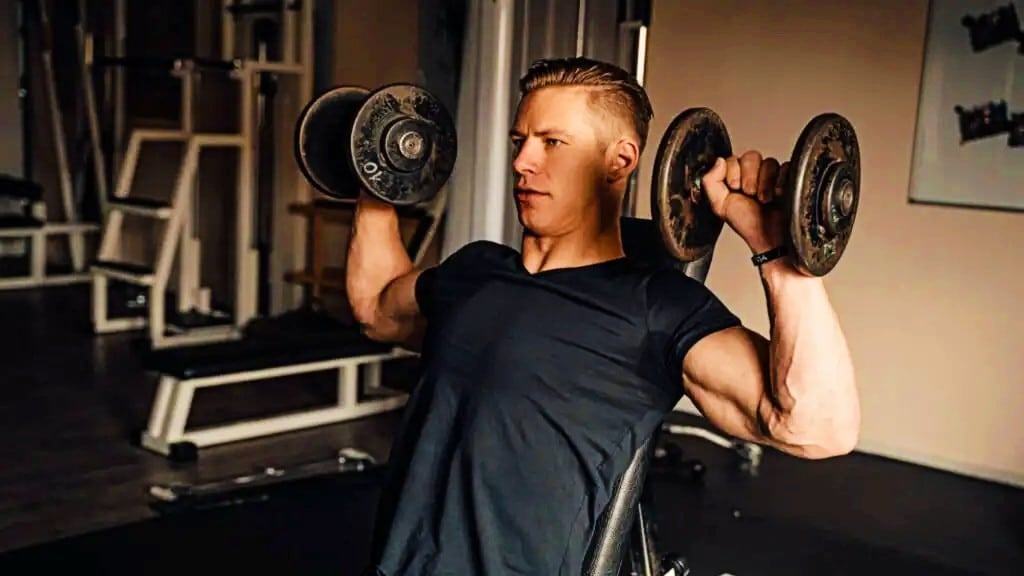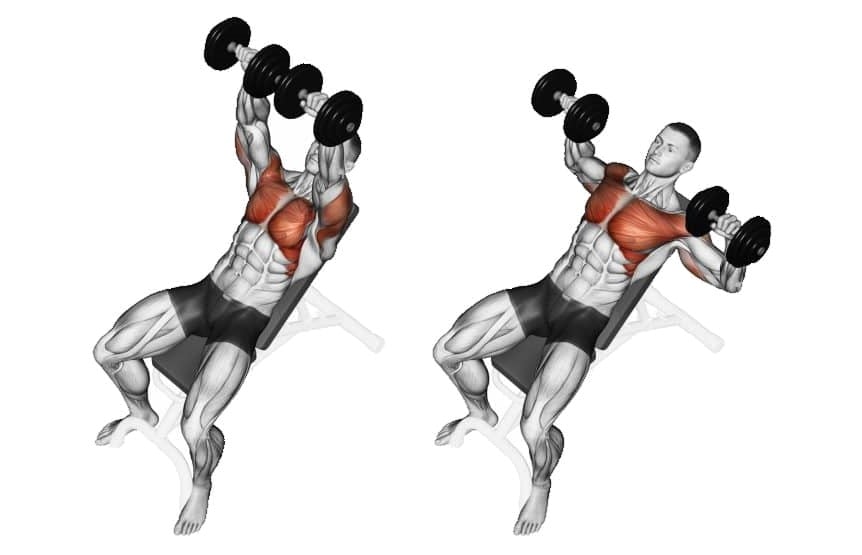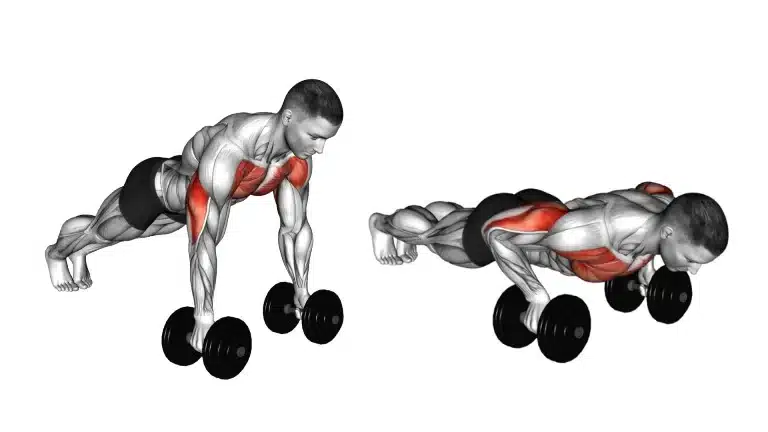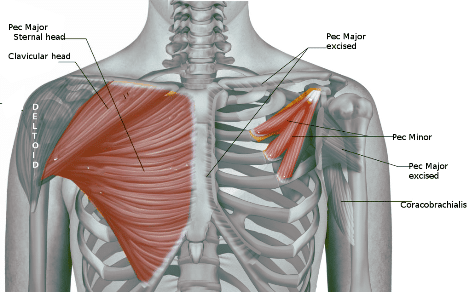Are you looking to strengthen and tone your chest and shoulders? Look no further than your trusty set of dumbbells.
You can target and achieve a stronger, more defined upper body with just a few simple dumbbell exercises.
The Chest and shoulder is a muscle pairing as old as the dumbbell press, and push-ups. It helps improve muscle strength and endurance.
This blog post will guide you through various effective chest and shoulder workouts using dumbbells at home or in the gym.

- Why You Should Train Chest and Shoulders Together
- 12 Best Chest And Shoulder Exercises With Dumbbells
- 1. Dumbbell Bench Press
- 2. Dumbbell Pullover
- 3. Incline Dumbbell Press
- 4. Dumbbell fly
- 5. Decline Dumbbell Fly
- 6. Dumbbell Push-Up
- 7. Dumbbell Shoulder Press
- 8. Arnold Shoulder Press
- 9. Dumbbell Lateral Raise
- 10. Bent Over Dumbbell Lateral Raise
- 11. Dumbbell Upright Row
- 12. Dumbbell Shrug
- Advantages of Doing a Dumbbell Chest and Shoulder Workout
- Chest and Shoulder Workout with Dumbbells at Home
- Chest and Shoulder Muscles Anatomy
- Chest Anatomy
- Shoulder Anatomy
- FAQ
- Can you train chest and shoulder together?
- How Many Sets and Reps Should I Do?
- Chest and shoulder superset workout
- How often should I do a chest and shoulder workout with dumbbells?
- Can I do a chest and shoulder workout with dumbbells at home?
- Takeaways
Why You Should Train Chest and Shoulders Together
Compound workouts naturally activate synergistic and stabilizer muscles alongside the main target muscle.
Training chest and shoulders together is a classic bodybuilding strategy because many of the same supporting muscles are used in both chest and shoulder exercises.
For EXAMPLE
When you do a dumbbell press, the pectorals are one of the target muscles. However, there are many other Synergistic and stabilizer muscles acting in this motion, such as the Anterior Deltoid, Triceps Brachii, Biceps Brachii.
Combining these muscles in one workout makes your training schedule easier and gives you more time for other muscles during the week.
Note: You must first train your chest rather than your shoulder during your workout routine. This is because your chest muscle will need your full energy and is most likely the heaviest to train and gain in terms of muscle.
12 Best Chest And Shoulder Exercises With Dumbbells
So, here’s a list of a few of the best chest and shoulder exercises using dumbbells that help you build up a strong and healthy body and muscles.
1. Dumbbell Bench Press
The dumbbell bench press is a great way to add muscle mass to the chest. The shoulders and triceps will be indirectly involved as well.
The barbell bench press has a limitation that it does not involve the full range of motion. The dumbbell bench press overcomes this limitation.
The dumbbell bench press provides an extra range of motion at the top for complete chest development. Moreover, dumbbells also demand better coordination, forcing the stabilizing muscles to assist as well.

How To Do It
- Lie flat on the bench, keeping your feet on the floor for better balance, with a dumbbell in each hand.
- Hold the Dumbbells straight overhead, palms facing forward.
- Now, lower the weights to your outer chest, stretching the chest to the maximum at the bottom.
- Then raise it until your arms are nearly locked out, and keep the dumbbells very close to each other.
Tips
- Keep a controlled motion, and avoid jerky movements.
- Keep your elbows close to your sides.
- Let your back keep a natural arch with a slight gap between your lower back and the bench.
2. Dumbbell Pullover
A Dumbbell Pullover is the best exercise to build a strong rib cage and build serratus anterior muscle to build a complete chest and back.
Pullovers work directly on the serratus anterior muscle to develop the back.
This exercise is performed by lying across a bench with a moderate-weight dumbbell in your hands.

How To Do It
- Lie across on a bench on your shoulders so that your head is hanging.
- Grasp a dumbbell with both hands and get it straight over your chest.
- Lower the dumbbell in an arc, slowly getting a good stretch in your rib cage.
- Lower the dumbbell as far as possible and then raise it back to the starting position.
Tips
- Exhale while you exert.
- Maximum stretching ensures the greatest expansion of the rib cage.
- Relax your hips and let them fall as relaxed hips help in extra expansion
3. Incline Dumbbell Press
The Incline Dumbbell Press Exercise is an excellent way to develop the middle and the upper pectoral muscles.
Just like the Incline bench press, the Incline dumbbell press works mostly on the upper chest, but dumbbells allow a full range of motion and, therefore, are better than the bench press in some ways.
It adds an extra range of motion at the top for complete chest development.
The study found that the most activity for the upper part of the pectoralis major muscle occurred when the bench was angled at 30 degrees.

How To Do It
- Lie back on an incline bench. Ensure the bench is adjusted to 30–45 degrees on an incline.
- Clean the dumbbells and lift them straight overhead. Feel a good chest squeeze at the top.
- Lower the dumbbells and feel a good chest muscle stretch at the bottom.
- Hold for a second, then press the dumbbell back to the starting position.
Tips
- Exhale while pushing dumbbells upwards, and do this in a controlled manner.
- Set the bench at about 30–45 degrees inclined. Do not go more upright as the stress shifts more to the shoulders rather than the chest area.
- Vary bench angles to hit different angles of the chest.
4. Dumbbell fly
The dumbbell fly utilizes a chest fly movement pattern to isolate the chest muscles. It helps the muscles to grow better and become stronger.
It is often thought of as a classic bodybuilding movement, as the goal of the exercise is to isolate the chest for aesthetic purposes.
The dumbbell fly targets all areas of the pecs, but most significantly the inner chest.
Try other variations of dumbbell fly:

How To Do It
- Lie on the flat bench with your feet flat on the floor.
- Lift your arms straight up from your shoulders and the dumbbells directly over your upper chest.
- Slowly lower your arms to your sides until your wrists reach about shoulder level or slightly above.
- Move your arms back to the middle of your body and use your pec muscles to bring them together.
Tips
- Perform press in a controlled manner.
- Exhale during the concentric (muscle-shortening) part of the motion.
5. Decline Dumbbell Fly
The decline dumbbell chest fly is a variation of the dumbbell fly used to target the chest muscles.
In particular, the decline dumbbell chest fly targets the lower chest due to the decline angle used.

How To Do It
- Grab a dumbbell in each hand and lie on your back on a decline bench.
- Hook your feet into the foot pad or roller.
- Extend the dumbbells above your chest.
- Turn the palms to face each other and the dumbbells directly over your upper chest.
- Slowly lower your arms to your sides until your wrists reach about shoulder level or slightly above.
- Bring your arms back toward the midline of your body.
Tips
- Keep the movement slow and controlled.
- Use a slight decline, such as 30 degrees. Extremes are never the best option.
- If you’re using very heavyweights, have a spotter to handle dumbbells for you once your body is in position.
6. Dumbbell Push-Up
Push-Ups are the best bodyweight exercise to build your entire upper body, including the chest, triceps, and shoulders.
Push-Ups can be a real challenge if done at various angles and with the right intensity to build muscle and strength.
Dumbbell push ups target the same muscle groups as regular push ups, but they can also provide an additional challenge by requiring additional stability and balance.

How To Do It
- Grip a dumbbell in each hand and get into a plank position with your palms facing down towards the floor.
- Now, raise yourself off the ground, straightening your elbows and your arms, but keep your elbows close to your body.
- Raise until your elbows are locked, and pause momentarily at the movement’s top.
- Now lower your body under slow, sustained motion, feeling the motion all the way down until your chest is very close to the ground.
Tips
- Exhale while you exert.
- Brace your core throughout your chest workout to keep it engaged.
Know More: Bodyweight Chest Exercises: Beginner To Advance
7. Dumbbell Shoulder Press
The overhead dumbbell press is one of the best upper body exercises for gaining muscle and overall shoulder strength.
The dumbbell overhead press can be done in sitting or standing positions and with dumbbells held horizontally at the shoulders.
The dumbbell overhead press is a very significant exercise to build front and side deltoid muscles.

How To Do It
- Sit at the end of a flat bench and hold a dumbbell in each hand at shoulder level.
- Your palms should be facing forward, and your elbows should be at a 90-degree angle.
- Push the dumbbells up overhead until your arms are fully extended.
- Pause briefly at the top of the movement.
- Then, slowly lower the dumbbells back down to the starting position.
Tips
- Avoid arching your lower back or using momentum to lift the dumbbells.
- Keep a controlled motion and avoid jerky movements.
- Make sure to keep your elbows slightly bent at the top of the movement to avoid locking them out.
Know More: Best Dumbbell Shoulder Exercises & Workouts For Mass
8. Arnold Shoulder Press
The Arnold dumbbell shoulder press exercise is an excellent shoulder muscle-building exercise.
Arnold’s press stands out from the crowd as the best exercise with the best range of motion for shoulder muscles.
It gives a wide range of motion as you lower the dumbbells well down in front, giving that maximum stretch other shoulder exercises lack.

How To Do It
- Stand straight, holding a dumbbell in each hand.
- Raise the dumbbells to the shoulder position with palms facing you.
- Now press the dumbbells overhead just like dumbbell presses, but twist them so that palms face forward at the movement’s top.
- Now lower the dumbbells in a reverse movement.
Tips
- Inhale when you lower the weight and exhale when you lift.
- Keep a controlled motion and avoid jerky movements.
- Keep a strict form.
- Do not lock your arms overhead.
9. Dumbbell Lateral Raise
The dumbbell lateral raise is a great exercise for targeting the medial deltoids.
Although, it also engages the anterior and posterior heads to a lesser extent.
You can also perform this exercise seated or with alternating arm raises for an added variation.
Try different variations:

How To Do It
- Hold a dumbbell in each hand and bring the weights together in front of you.
- The palms should be facing each other.
- Now bend your elbows and raise the dumbbells to your sides.
- Lift them to a point slightly higher than your shoulders.
- Now lower the dumbbells in a controlled manner back to the starting position.
Tips
- The form is a very important part of this exercise.
- Keep your core engaged and maintain proper form.
- Don’t just swing your arms. Keep controlled motion throughout the exercise.
- Perform a warm-up with 50% weight for 1–2 sets.
Know More: 10 Best Dumbbell Shoulder Workouts You Can Do At Home
10. Bent Over Dumbbell Lateral Raise
The bent-over raises are an excellent exercise to isolate and work specifically on rear deltoid muscles.
For complete shoulder muscle development, bent-over raises are a must-do.
This exercise hit specifically the rear shoulder head by isolating it better than any other shoulder exercise.
This exercise can be performed in both a standing and a seated position. I prefer the seated version as it calls for strict movement.

How To Do It
- Sit at the end of a bench with a pair of dumbbells.
- Bend forward and let the dumbbells hang on your sides.
- Lift the dumbbells, raising them on your sides to a level slightly higher than your shoulders.
- Now lower the dumbbells back to your sides.
Tips
- Your arms should be parallel to your shoulders.
- Keep strict form to isolate the rear delts.
Learn More: Rear Delt Fly: Muscles Worked, Benefits, Variations
11. Dumbbell Upright Row
The dumbbell upright row is an effective exercise for targeting the shoulders, upper back, and traps. Upright Rows, along with shrugs, build massive traps.
Upright rows can be performed using a barbell, dumbbells, cable, or smith machine.

How To Do It
- Stand with your feet shoulder-width apart.
- Hold the dumbbell in each hand in front of your thighs.
- Your palms should face your body, and your elbows should be slightly bent.
- Keeping your core engaged, lift the dumbbells up towards your chin, leading with your elbows.
- Pause briefly at the top of the movement, then slowly lower the dumbbells back down to your thighs.
- Repeat for the desired number of repetitions.
Tips
- Remember to exhale while you exert.
- Keep a controlled motion and avoid jerky movements.
- Make sure to keep the dumbbells close to your body and avoid swinging them.
- Avoid arching your back. Keep your back straight.
12. Dumbbell Shrug
The dumbbell shrug is a variation and one of the best exercises to build bigger and stronger trapezius muscles.
Shrug exercise can be done extremely heavily to thicken the traps, which really helps you in doing back poses.
This is one of the best trap isolation exercises for trapezius muscle.

How To Do It
- Stand upright, keeping arms at your sides and with a heavy dumbbell in each hand.
- Raise your shoulders as high as you can, as if trying to touch them to your ears.
- Hold at the top for a moment, then release and return to the starting position.
Tips
- Inhale when you lower the weight and exhale when you lift.
- Adding a pause at the top of the movement can help to enhance the mind-muscle connection.
- Limit momentum and excessive jerking or bouncing of the weight.
Know More: 12 Best Mid-Trap Exercises For Muscle Mass And Strength
Advantages of Doing a Dumbbell Chest and Shoulder Workout
- The chest and shoulder workout with Dumbbells requires more balance than barbells or machines, which can lead to greater muscle fiber recruitment.
- Dumbbell affords a greater variety, preventing physical and mental burnout.
- Dumbbell requires more muscular control and enhances kinesthetic awareness.
- Chest and shoulder workouts with dumbbells allow for greater joint safety and stabilization and allow the joints to move naturally within their range of motion.
- Dumbbell variations allow for a greater range of movement (ROM), leading to increased muscle fibers recruited.
- Chest and shoulder workouts with dumbbells allow unilateral training (training one limb at a time), increase core stability, and improve muscular imbalances.
Chest and Shoulder Workout with Dumbbells at Home
Combining chest and shoulder workouts is a great way to maximize your time in the gym and get a full upper body workout.
| Exercise | Sets x Reps | Rest |
|---|---|---|
| Dumbbell bench press | 3×8-10 | 60–90 seconds |
| Dumbbell shoulder press | 3×8-10 | 60–90 seconds |
| Dumbbell flyes | 3×10-12 | 60–90 seconds |
| Dumbbell lateral raises | 3×10-12 | 60–90 seconds |
| Dumbbell pullovers | 3×10-12 | 60–90 seconds |
| Dumbbell upright rows | 3×10-12 | 60–90 seconds |
Chest and Shoulder Muscles Anatomy
Before diving into chest and shoulder workouts with dumbbells, it’s significant to understand the anatomy of the muscles you’ll be targeting.
Chest Anatomy
The chest muscles, or pectorals, consist of two main muscle groups: the pectoralis major and pectoralis minor.
- The pectoralis major is the larger of the two muscles and is responsible for movements such as pushing and pulling.
- The pectoralis major muscle group is mainly divided into the upper chest and the lower chest section.
- The pectoralis minor is a smaller muscle located underneath the pectoralis major and stabilizes the shoulder blade.

Shoulder Anatomy
The shoulder muscles, or deltoids, consist of three main muscle groups:
- Anterior deltoid: located at the front of the shoulder and is responsible for lifting the arm in front of the body.
- Lateral deltoid: located in the middle of the shoulder and is responsible for lifting the arm to the side.
- Rear deltoid: located at the back of the shoulder and is responsible for pulling the arm backward.
You need to work all three of them, along with the trapezius muscle in the upper back, to build an impressive shoulder.

FAQ
Can you train chest and shoulder together?
Yes, you can train the chest and shoulders together by using dumbbells in your workout regime.
It’s actually preferred by many fitness gurus and bodybuilders to train them together, since you are already working the shoulder when doing chest.
How Many Sets and Reps Should I Do?
For just about every exercise of the chest or shoulder, 3–4 work sets (the real work you do, not warm-up sets) is a good choice.
But rep ranges fluctuate. You can go as low as 5 reps on heavy press, and up to 15–30 reps for accessory work.
Chest and shoulder superset workout
- Dumbbell Bench Press Superset with Dumbbell Shoulder Press
- Dumbbell Pullover Superset with Arnold Shoulder Press
- Incline Dumbbell Press Superset with Dumbbell Lateral Raise
- Dumbbell fly Superset with bent-over Dumbbell Raise
- Decline Dumbbell Fly Superset with Dumbbell Upright Row
- Dumbbell Push-Up Press Superset with Dumbbell Shrug
The best superset is that you can and effectively implement it in your workout. Try this workout, Superset.
How often should I do a chest and shoulder workout with dumbbells?
One or two times per week can be effective.
However, if you’re looking to build more muscle or are training for a specific goal, you may want to increase the frequency of your workouts.
Can I do a chest and shoulder workout with dumbbells at home?
Yes, you can definitely do a chest and shoulder workout with dumbbells at home.
All you need is a set of dumbbells and some space to move around.
Takeaways
A chest and shoulder workout with dumbbells can effectively strengthen and tone your upper body.
The above dumbbell exercises will allow you to target your chest and shoulder muscles from different angles and with different intensity levels.
Focusing on proper form, using a challenging weight, incorporating variety into your routine, prioritizing nutrition and rest, and maintaining consistency are important to achieve maximum results.
Let me know how it’s going – I’d love to hear about your successes and where you’d like more support for even better workouts!
STAY FIT, LIVE A HAPPY AND HEALTHY LIFE

Manish brings over 10 years of hands-on experience in weight lifting and fat loss to fitness coaching. He specializes in gym-based training and has a lot of knowledge about exercise, lifting technique, biomechanics, and more.
Through “Fit Life Regime,” he generously shares the insights he’s gained over a decade in the field. His goal is to equip others with the knowledge to start their own fitness journey.
